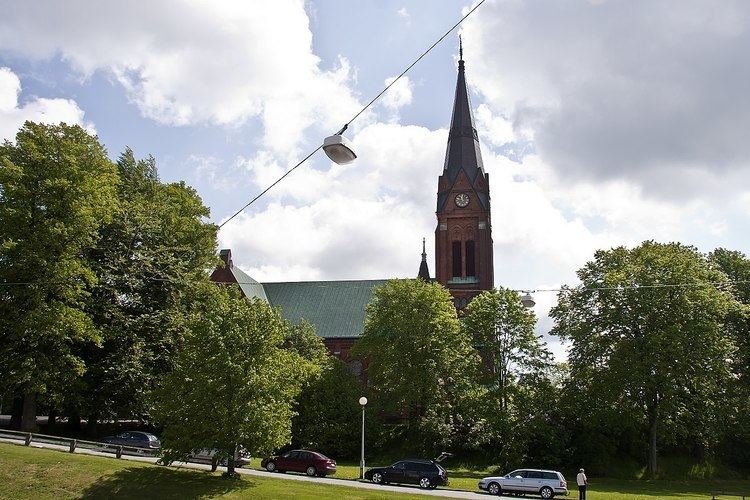Consecrated 1890 Phone +46 31 731 83 00 | Denomination Catholic Opened 6 July 1890 Groundbreaking 1888 | |
 | ||
Address Herrgårdsgatan 2, 412 74 Göteborg, Sweden Similar Örgryte Old Church, S:t Pauli kyrka, Härlanda Kyrka, Björkekärrs Församling, Vasa Church - Gothenburg | ||
Örgryte new church (Swedish: Örgryte nya kyrka) is a church in the gothic style on Svalberget. The church is a part of the Örgryte congregation (Swedish: Örgryte församling) in Gothenburg. Because of the nature of the plot, the church is oriented northeast–southwest. It has a cross layout with open rafters and vaulted, pentagonal chancels. The church tower is almost 60 meters tall.
Contents
History
From 1870, the churchgoers of Örgryte contemplated a major project as their existing 400-seat church could not contain the growing congregation. In 1885, under the leadership of the Reverend Magnus Ekberg, construction of a new church was proposed. A collection was taken and the church agreed to take a loan of SEK 50,000 to meet the estimated cost. Among the generous contributors were merchant David Lundstrom of Underås farm, James Dickson, David Carnegie and Oscar Ekman. The new church was to be more than twice the size of the existing church, seating over 1,000 people. The new building followed the trend of its contemporary churches and was made from brick. The building required firm ground, so it was built on top of the Svalberget. Some of the major purchases were made as individual donations. The local brewer, JW Lyckholm of Skår, paid for two bells. Captain Pontus Virgin of Kålltorp paid for the altar while the stained glass windows were donated by the wholesaler Peter Hammarberg.
The architect was Adrian C. Peterson, and the builder was F O Peterson. Work began in the summer of 1888, and the church was consecrated on July 6, 1890 by bishop Edvard Rodhe. The final cost was 226,000 SEK. Donations covered slightly more than 120,000 and the remaining sum was procured through a loan of SEK 50,000 and from the church fund.
The church is built in red Börringe Brick from Skåne, and did not receive electricity until 1908. The facades have rich tegelornering, stone moldings and forgings.
A thorough restoration took place in 1937 under A. Forsséns line, and the pulpit was moved. In 1952, four painted circular windows of the chancel were transferred to the stands, while other painted korfönster (stained glass) from 1889, magazines were.
Church organs
The church has two organs:
The church bells
The church tower has two bells, each with the inscription:
The Oscar II government when D r E. H. Rodhe was a bishop in the Diocese of Gothenburg and Dean J. M. Ekberg vicar of Örgryte
Mech. Werkstad in 1899 the factory owner J. W. Lyckholms expense.
The larger bell has the inscription:
Come, for all things are now ready. Luc. 14:17 Tacker Lord into his gates Lofver him in his yard Come here from all locations Prices on about us, care
Keeps faith forever.
... And the smaller
It's a kostelig things to thank the Lord
Glory to the Father and His Son
The holy spirit in the throneHoly trinity Be praised and praise forever.
Altarpiece
In 1950, the church painter Thor Fagerkvist (1884–1960) was commissioned to paint an altarpiece for the church. It would replace Carl Johan Dyfverman's crucifixion group from 1890. It was a triptych consisting of five oil paintings on canvas, three of which are usually visible with pictures related to Christmas, Easter and Pentecost, while the cabinet is closed during Lent, and then shows the other two paintings, photographed wagon and no Gethsemane. The frame was designed by architect Axel Forssén.
The great altar of cut oak wood was placed on the altar in the church in 1890, and was the work of Dyfverman. The subject is the crucified Jesus with Mary, the other Mary and the disciple John, beneath the cross. The sculpture was painted in 1923, and in 1969 was restored by artwork conservator Torsten Öhlén. Crucifixion group was moved in 1951 to its current location in the transept.
Altar
On the altar stood a 1952 crucifix of ivory and ebony by Gothenburg sculptor Henry Johansson, as well as the altar a gift of parishioners. Since the altar faced Assembly crucifix moved to the sacristy.
Font
The baptismal font was designed by architect Axel Forssén. Dean Ekberg's successor, Reverend Magnus Nilman (1855–1927), donated it along with dopfatet of copper to the new church in 1927 When was returned while the maroon kalkstensfunten to the old church.
